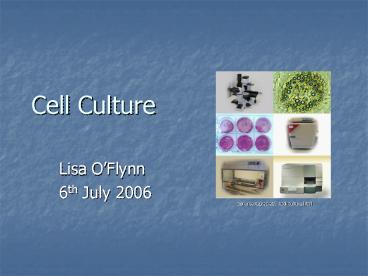Cell Culture PowerPoint PPT Presentation
1 / 12
Title: Cell Culture
1
Cell Culture
- Lisa OFlynn
- 6th July 2006
Genome.tugraz.at//CellCulture.html
2
Cell Culture Defined
- Process by which cells are grown under controlled
conditions - 19th Century Sydney Ringer developed salt
solution to maintain animal heart cells in vitro - 1907-1910 Ross Granville Harrison methodology
of tissue culture - 1950s technique developed
Ross Granville Harrison
yalemedicine.yale.edu/ym_wi03/faces.html
3
Types of cell culture
- Primary Cell Culture
- Derived directly from excised normal animal
tissue heterogeneous, later dominate by
fibroblasts - Continuous Cultures
- Suspension (as a single cell or small free
floating clumps) e.g. blood lines - lymphoma - or Monolayer that is attached to the tissue
culture flask e.g. CHO (Chinese Hamster Ovary)
CHO Cells
www.essen_instruments.com/IncuCyte_Movies.htm
4
- Cells lines of human origin- controversial in
bioethics due to the fact cells may out live
parent organism or they maybe used in the
discovery of lucrative medical treatments - 1990 Supreme Court of California human patients
have no property rights on the cell lines derived
from organs removed with their consent.
5
Culture Maintenance
- Key is to mimic the environment in which they
were found - Cells maintained at
- - 37C
- - 5-10 CO2
- - pH controlled with buffered sodium
bicarbonate/carbonic acid - - humidity maintained
6
Culture Maintenance
www.usak.ca
- Laminar Flow Hood
- -UV light
- -on 10-20mins before use
- -surfaces wiped with 70 ethanol before and
after use - Cultures examined daily
7
Harvesting Cells
- Cells must be passaged (split) regularly to
maintain life span - Population density semi-confluent state log
phase - Methods
- Mechanical rubber spatula, quick and easy but
significant cell death - Proteolytic enzymes Trypsin, collagenase, fast
reliable but may damage cell surface proteins - EDTA gentler method to detach cells
http//www.bdbiosciences.com/discovery_labware/Pro
ducts/cell_cultureware/cell_culture_flasks/images/
flask_family.jpg
8
Advantages of Cell Culture
- Minimize variability among experiment samples
- Reproducible results can be obtained by using
clonal cell batch - Cells can be stored in liquid nitrogen and
returned to culture at a later date
9
Disadvantages of Cell Culture
- After a period of continuous growth cell
characteristics can change and may become quite
different from those at the start - Animal cells require 18-24hrs to double this
leaves cells vulnerable to contamination from
bacteria which would out grow the cells
10
Precautions
- Risk assessment low, medium or high
- Containment reduces risk restrict staff movement
- Work areas must be uncluttered, reagents
correctly stored and labeled - Disinfection of work surfaces, equipment and
waste - Waste-inactivated overnight in a solution of
hypochlorite
11
Applications
http//tsmb.cryst.bbk.ac.uk
- Investigate normal physiology / biochemistry of
cells e.g. cell metabolism - Study the effects of various chemical compounds
or of drugs on specific cell types - Manufacture of viral vaccines many other
products of biotechnology e.g. rDNA technology in
animal cell culture including enzymes, hormones
and immunobiologicals
12
References
- http//en.wikipedia.org/wiki/Cell_culture_techniqu
es - http//www.biotech.ubc.ca/Bioengineering/CellCultu
re/index.htm - www.research.umbc.edu/jwolt/method5.htm
- CloneticsTM Airway Epithelial Cell Systems
Instructions for Use - Billie Ruth Bird, Francis T. Forrester Basic
Laboratory Techniques in Cell Culture - Images
- yalemedicine.yale.edu/ym_wi03/faces.html
- www.usak.ca
- Genome.tugraz.at//CellCulture.html
- www.essen_instruments.com/IncuCyte_Movies.htm
- http//www.bdbiosciences.com/discovery_labware/Pro
ducts/cell_cultureware/cell_culture_flasks/images/
flask_family.jpg - http//tsmb.cryst.bbk.ac.uk/

